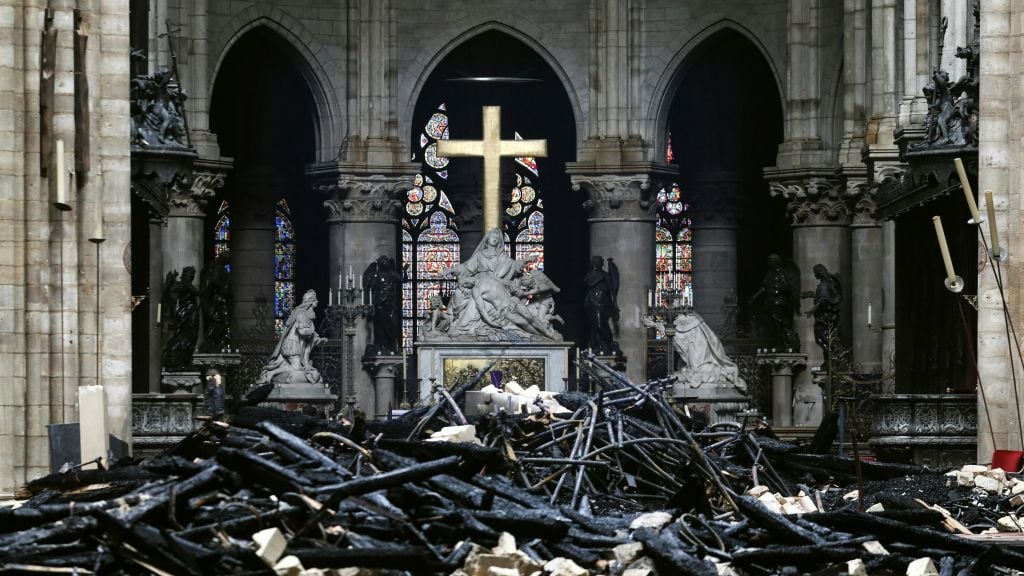
The world is still reeling from the devastating fire that ripped through the cathedral of Notre Dame in Paris last night. Experts in the restoration of historical monuments estimate that it will take between 10 and 15 years and hundreds of millions of dollars to restore the edifice to its former glory after its iconic spire collapsed.
While the scale of the damage and the cost of repairs is being assessed, the French state has launched an official website to collect much-needed donations toward the cause. Billionaire art collectors François Pinault and Bernard Arnault were quick to bring the pot to some €300 million ($340 million). Further pledges came today from the cosmetics group L’Oreal, the Bettencourt family, and the Bettencourt Schueller foundation, which pledged an additional €200 million ($226 million), and the gas an energy company Total added a further €100 million ($113 million).
As emergency services battled the blaze, police and firefighters formed a human chain to evacuate the most priceless relics and moveable works of art. France’s culture minister Franck Riester shared images of the evacuation process to Twitter.
Riester told French radio this morning that it was “too early to say” whether some of the large-scale paintings on the inside of the cathedral survived the blaze. These include the 17th-century works the Visitation (1716) by Jean-Baptiste Jouvenet and Antoine Nicolas’s Saint Thomas Aquinas, Fountain of Wisdom (1648). Although he specified that the fire did not reach the inside of the cathedral where they are held, they are likely to have suffered water damage. “We will know more as soon as we can get back inside and establish a diagnosis,” Riester said. “We must remove the paintings as soon as possible, clean them, dehumidify them, put them in a suitable place for conservation and begin restoration.”
Priceless treasures believed to have perished in the blaze include many of the cathedral’s famous gargoyles, as well as the so-called “forest” of medieval-era oak carpentry that adorned the cathedral roof, which is thought to have added fuel to the fire. Relics held in the spire that collapsed, including some of the patron saints of Paris, St. Denis and St. Genevieve, one of the seventy thorns from the original Crown of Thorns, and a reliquary rooster, are all thought to have perished.
On a more optimistic note, here are seven works that are known to have survived the blaze, some of which minister Riester says will be removed from the City Hall to been overseen by conservationists at the Louvre later this week.
The Crown of Thorns
A priest wipes the Crown of Thorns, a relic of the passion of Christ, at the Notre Dame cathedral in Paris on April 14, 2017. Photo by Philippe Lopez/AFP/Getty Images.
The cathedral’s most precious item, the Holy Crown of Thorns, which is believed to have been placed on Jesus’s head before he was crucified, was confirmed to be safe by minister Riester this morning. The relic is around eight inches in diameter and made from braided rushes bound by gold wire, although it was initially composed of 70 spines which have been distributed around the world.
The Tunic of Saint Louis
A view of the tunic allegedly worn by Saint Louis on display inside the Notre Dame of Paris cathedral in 2012. Photo by Patrick Kovarik/AFP/Getty Images.
This holy tunic is thought to have been worn by the 13th-century crusader King Louis IX when he brought the Crown of Thorns to Paris after arranging for its purchase from the Latin Emperor of Byzantium. Louis, who would later be made a saint, walked barefoot behind the relic as it was transported to France.
The “Mays”
Sébastien Bourdon, The Crucifixion of Saint Peter (1643).
Thirteen paintings known as the “Mays,” from a series of 17th- and early 18th-century works commissioned by the city’s goldsmiths’ guild to give to the cathedral in May of each year between 1630 and 1707, are also believed to have survived. The cathedral’s rector, Monsignor Patrick Chauvet, confirmed that the works housed in the chapel’s nave, were evacuated during the fire, France Inter reports.
Bronze Statuary
Patrick Palem, a heritage restoration expert, shows the head of one of the statues which sat around the spire of Notre Dame, stored in SOCRA workshop in Marsac-sur-Isle near Bordeaux. Photo by Georges Gobet/AFP/Getty Images.
Sixteen bronze statues depicting the Twelve Apostles and the New Testament’s four evangelists were removed from the cathedral’s spire for restoration just days before the outbreak of the blaze.
The Rose Windows
The South Rose at Notre Dame of Paris. Photo by Godong/UIG via Getty Images.
The cathedral’s three enormous round stained-glass windows, known as the Rose Windows, date back to the 13th century. They depict numerous saints and prophets, with the Virgin Mary and Christ represented in the centerpiece. Eye witnesses report that the windows have held up, though they are blackened and the lead that binds their various panels may have melted. Monsignor Patrick Chauvet, the head administrative cleric at Notre Dame, has said they may still have to be dismantled.
The Great Organ
The organ at Notre Dame de Paris Cathedral in Paris in 2018. Photo by Ludovic Marin/AFP/Getty Images.
The cathedral’s 19th-century symphonic organ, which has five keyboards and some 8,000 pipes, is believed to date back to the Middle Ages. Culture minister Riester said yesterday, however, that it appears to be “badly damaged.”
The Bells
Notre Dame of Paris cathedral bell. Photo by Godong/UIG via Getty Images.
The oldest bell in the cathedral, which has been in situ since 1861, was famously tolled to mark the end of World War II. The bell, officially named “Emmanuel” but nicknamed “the bumblebee” weighs more than 13 tons. The smaller bells, named Marie, Gabriel, Anne-Geneviève, Denis, Marcel, Etienne, Benoît-Joseph, Maurice, and Jean-Marie, are also thought to have survived as the towers that contain them were untouched by the blaze.